Abstract
Anxiety is known to cause feelings of uneasiness, tension, and nervousness, and previous studies have noted that anxiety and its effects may have an effect on out-patient sedation for patients undergoing surgical procedures. In this study, we assess the effects of anxiety on 25 outpatients undergoing intravenous sedation for third molar extraction. Before the procedure, subjects completed the State-Trait Anxiety Inventory, and intraoperative patient movement was assessed using a subjective scale. We found that patients with a high level of preoperative anxiety had a greater degree of average intraoperative movement (P = .037) and also required a greater amount of propofol to maintain a clinically acceptable level of sedation (P = .0273) when compared with patients with less preoperative anxiety. Increased state anxiety and trait anxiety serve as predictors for an increased total dose requirement of propofol to maintain an acceptable level of sedation (r2 = 0.285, P = .0060, and r2 = 0.233, P = .0146, respectively). An increased level of trait anxiety was also a predictor of an increased degree of average intraoperative movement (r2 = 0.342, P = .0022). Patients who exhibit a high level of preoperative anxiety require a greater total dose of propofol to achieve and maintain a clinically acceptable level of sedation and are more prone to unwanted movement while under sedation.
Full text
PDF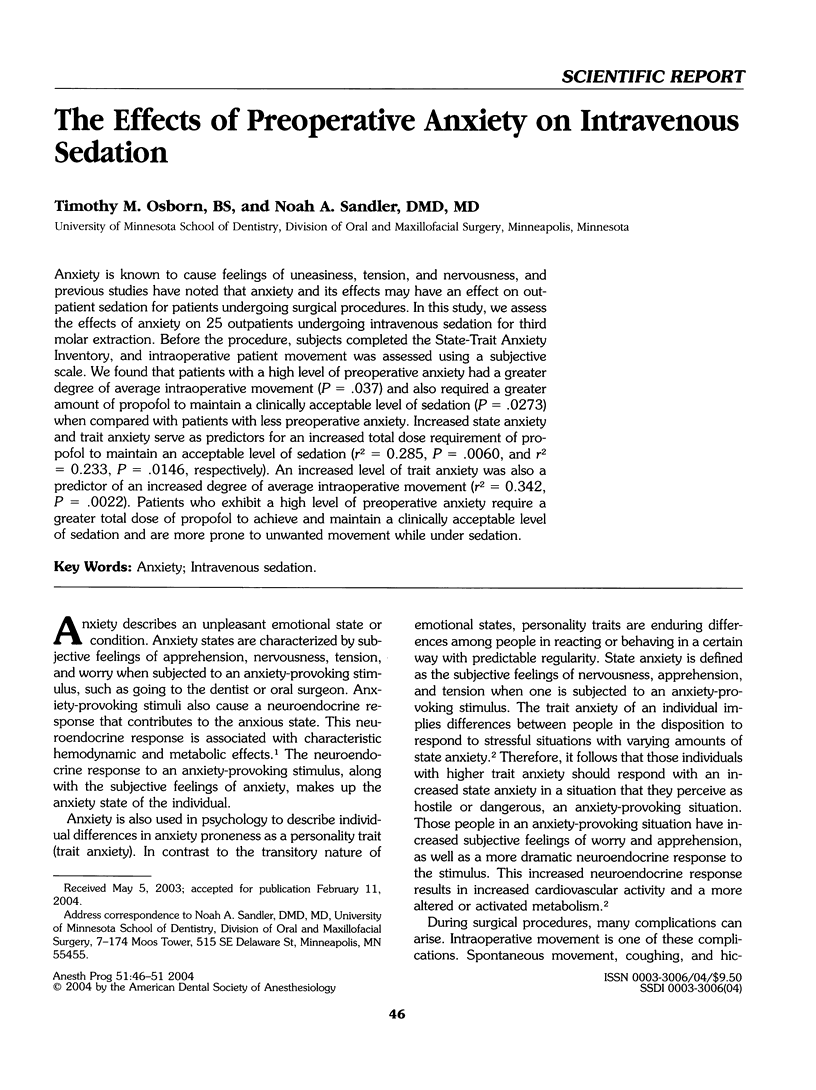
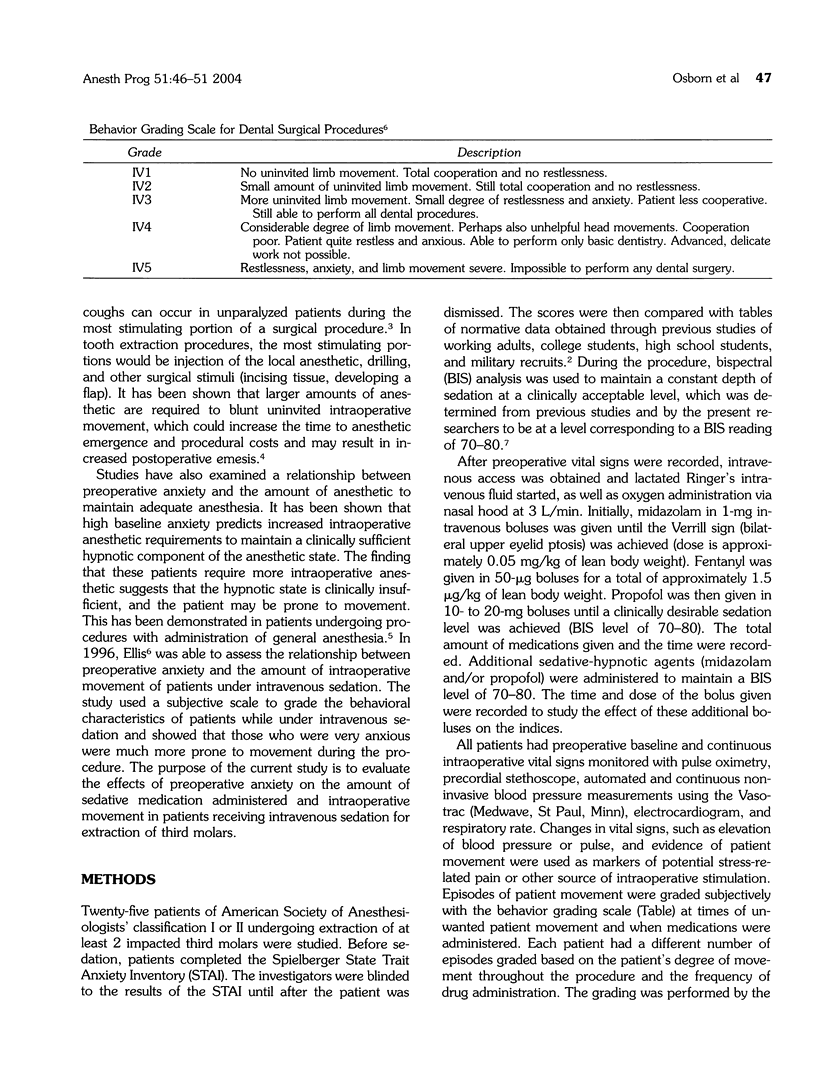
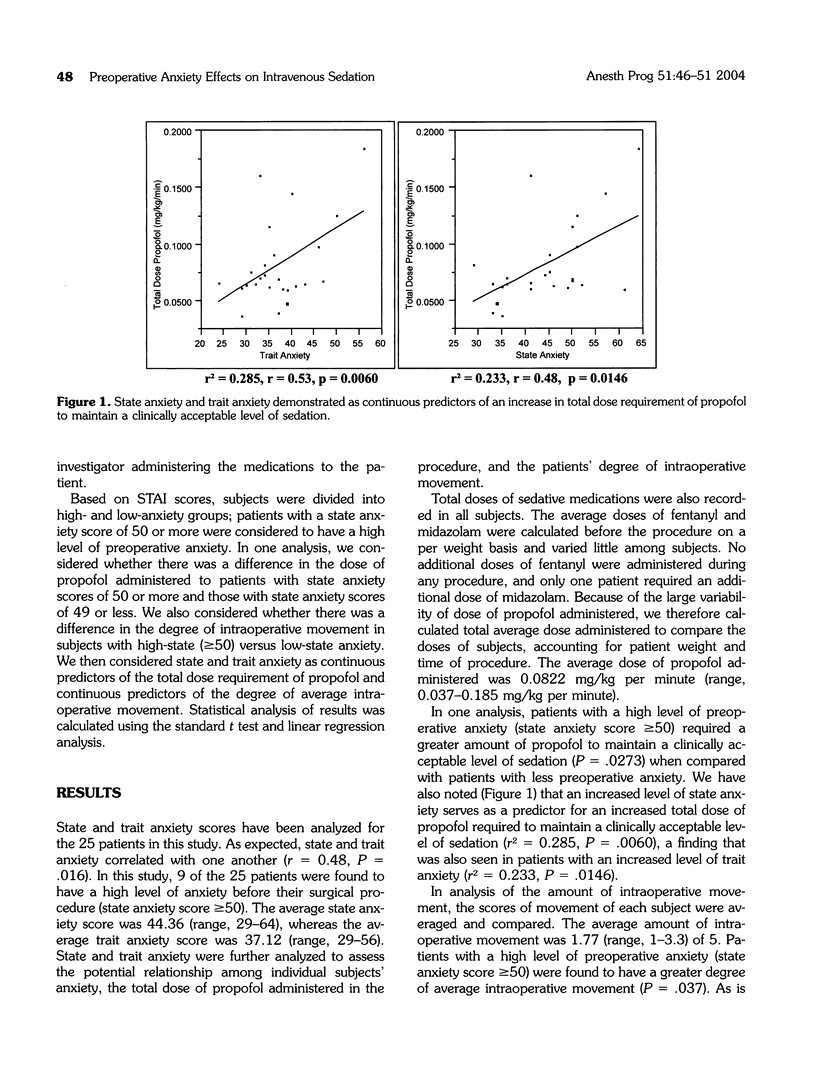
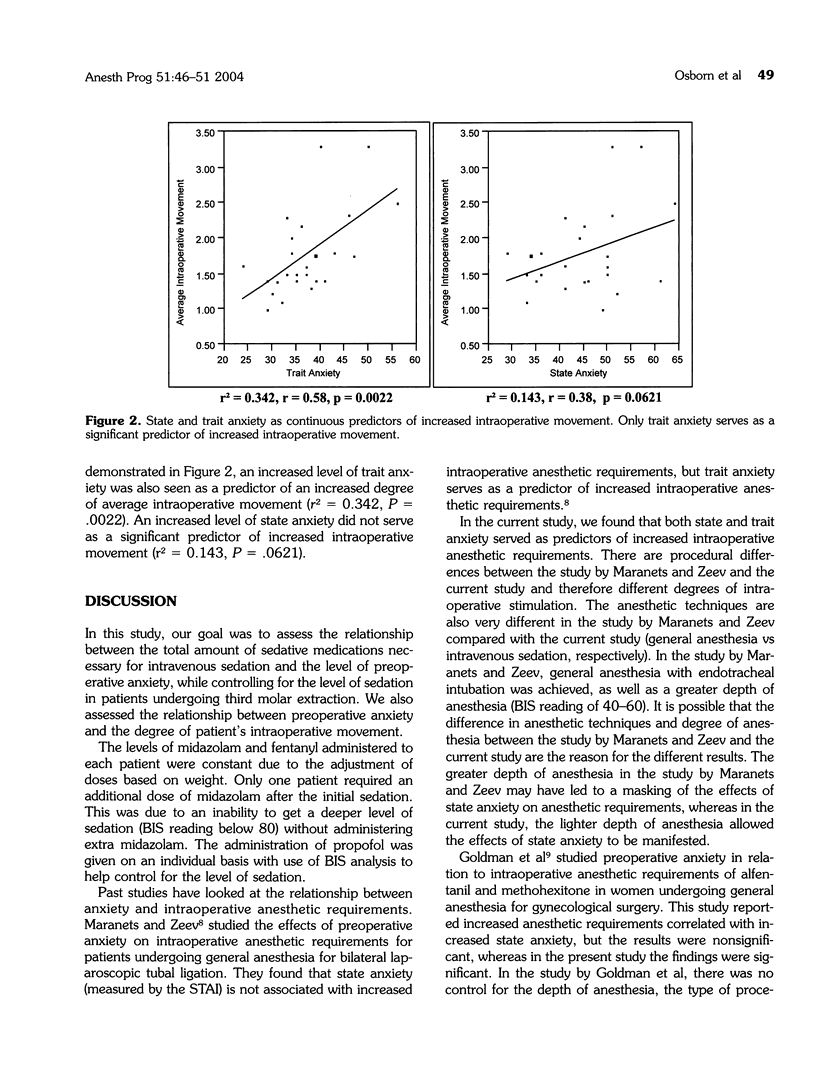
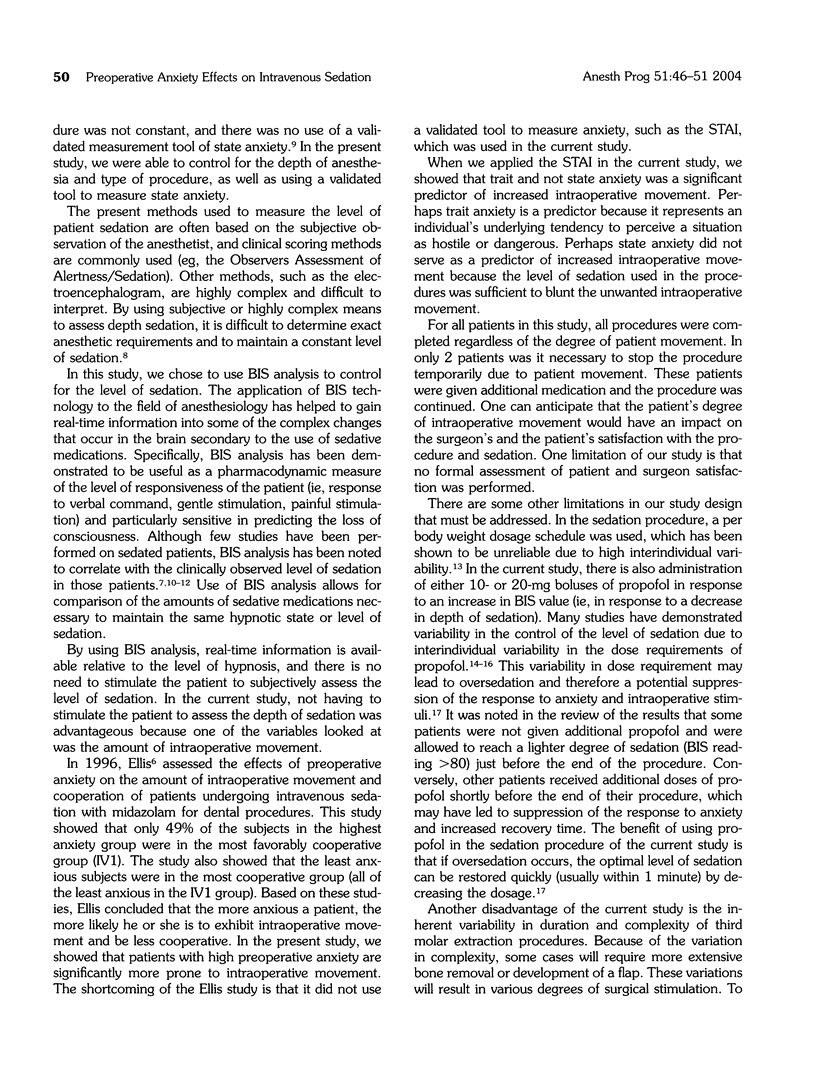
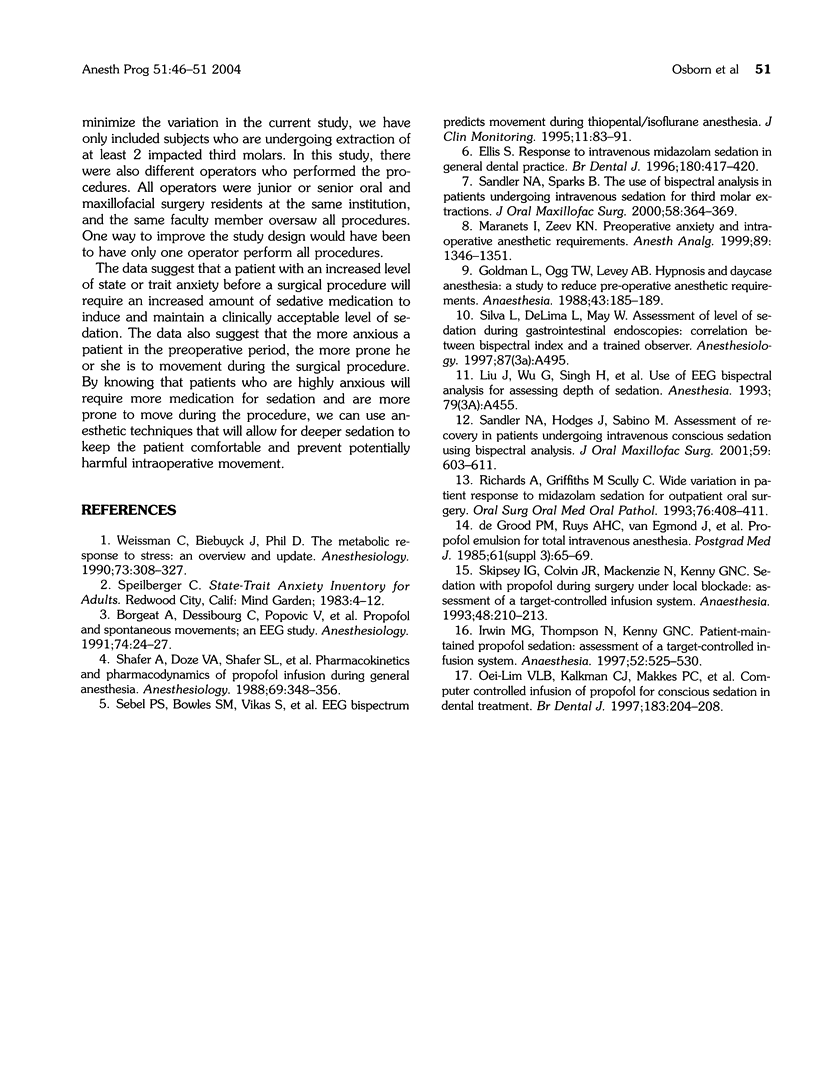
Selected References
These references are in PubMed. This may not be the complete list of references from this article.
- Borgeat A., Dessibourg C., Popovic V., Meier D., Blanchard M., Schwander D. Propofol and spontaneous movements: an EEG study. Anesthesiology. 1991 Jan;74(1):24–27. doi: 10.1097/00000542-199101000-00005. [DOI] [PubMed] [Google Scholar]
- Ellis S. Response to intravenous midazolam sedation in general dental practice. Br Dent J. 1996 Jun 8;180(11):417–420. doi: 10.1038/sj.bdj.4809108. [DOI] [PubMed] [Google Scholar]
- Irwin M. G., Thompson N., Kenny G. N. Patient-maintained propofol sedation. Assessment of a target-controlled infusion system. Anaesthesia. 1997 Jun;52(6):525–530. doi: 10.1111/j.1365-2222.1997.123-az0117.x. [DOI] [PubMed] [Google Scholar]
- Maranets I., Kain Z. N. Preoperative anxiety and intraoperative anesthetic requirements. Anesth Analg. 1999 Dec;89(6):1346–1351. doi: 10.1097/00000539-199912000-00003. [DOI] [PubMed] [Google Scholar]
- Oei-Lim V. L., Kalkman C. J., Makkes P. C., Ooms W. G., Hoogstraten J. Computer controlled infusion of propofol for conscious sedation in dental treatment. Br Dent J. 1997 Sep 27;183(6):204–208. doi: 10.1038/sj.bdj.4809467. [DOI] [PubMed] [Google Scholar]
- Richards A., Griffiths M., Scully C. Wide variation in patient response to midazolam sedation for outpatient oral surgery. Oral Surg Oral Med Oral Pathol. 1993 Oct;76(4):408–411. doi: 10.1016/0030-4220(93)90004-n. [DOI] [PubMed] [Google Scholar]
- Sandler N. A., Hodges J., Sabino M. Assessment of recovery in patients undergoing intravenous conscious sedation using bispectral analysis. J Oral Maxillofac Surg. 2001 Jun;59(6):603–612. doi: 10.1053/joms.2001.23366. [DOI] [PubMed] [Google Scholar]
- Sandler N. A., Sparks B. S. The use of bispectral analysis in patients undergoing intravenous sedation for third molar extractions. J Oral Maxillofac Surg. 2000 Apr;58(4):364–369. doi: 10.1016/s0278-2391(00)90911-x. [DOI] [PubMed] [Google Scholar]
- Sebel P. S., Bowles S. M., Saini V., Chamoun N. EEG bispectrum predicts movement during thiopental/isoflurane anesthesia. J Clin Monit. 1995 Mar;11(2):83–91. doi: 10.1007/BF01617729. [DOI] [PubMed] [Google Scholar]
- Shafer A., Doze V. A., Shafer S. L., White P. F. Pharmacokinetics and pharmacodynamics of propofol infusions during general anesthesia. Anesthesiology. 1988 Sep;69(3):348–356. doi: 10.1097/00000542-198809000-00011. [DOI] [PubMed] [Google Scholar]
- Skipsey I. G., Colvin J. R., Mackenzie N., Kenny G. N. Sedation with propofol during surgery under local blockade. Assessment of a target-controlled infusion system. Anaesthesia. 1993 Mar;48(3):210–213. doi: 10.1111/j.1365-2044.1993.tb06903.x. [DOI] [PubMed] [Google Scholar]
- Weissman C. The metabolic response to stress: an overview and update. Anesthesiology. 1990 Aug;73(2):308–327. doi: 10.1097/00000542-199008000-00020. [DOI] [PubMed] [Google Scholar]
- de Grood P. M., Ruys A. H., van Egmond J., Booij L. H., Crul J. F. Propofol ('Diprivan') emulsion for total intravenous anaesthesia. Postgrad Med J. 1985;61 (Suppl 3):65–69. [PubMed] [Google Scholar]


